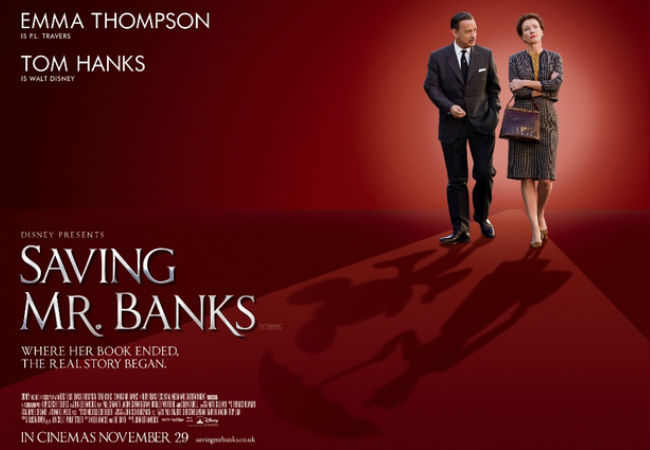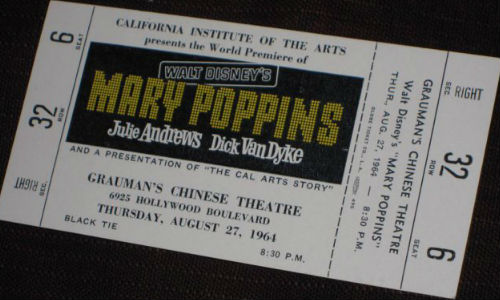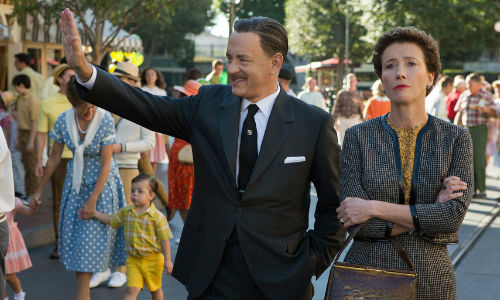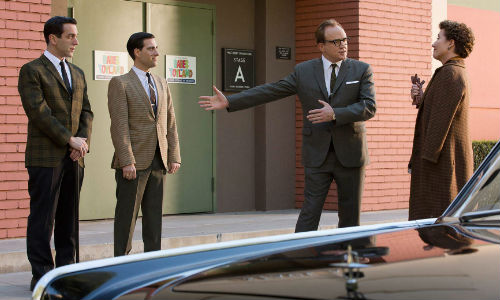
It’s often been observed that history is a malleable property, written by the victors, with facts added or deleted as the authors of a particular account see fit.
Naturally, this doesn’t just apply to the great epic moments of the past such as the fall of Rome or Genghis Khan’s rampages across Asia and Europe; it is just as true for far more recent events.
Take the case of Saving Mr Banks, where it extends to the highly romanticised but thoroughly engaging treatment of the fraught process that led to the creation of the last movie that Walt Disney made before his death, 1964’s Mary Poppins.
Much like the frosty persona of the woman who created Mary Poppins, writer P. L. Travers, played with cheerful disdain by Emma Thompson who’s clearly in her element gleefully throwing venomous bon mots around like verbal hand grenades, the process that led to the premiere of the movie on August 27, 1964 was fraught with angst, personality clashes and iron clad battles of competing, implacable wills.
By all accounts, Walt Disney, portrayed with genial likability and avuncular folksiness (for the most part anyway; there are moments when his steely exasperation cuts through) by Tom Hanks in his second great starring role of the year, was a man accustomed to getting his way, a media mogul whose mind once set, was not easily altered.
He firmly believed in honouring the promises he made, which is why he pursued P. L. Travers for the film rights for 20 years after assuring his daughters, who loved his books, that he would make a movie of their favourite bedtime story.

Pamela L. Travers, real name Helen Goff – she adopted the surname Travers in honour of her alcoholic but loving father who died when she was a child – was the immovable object to Disney’s irresistible force, equally determined to safeguard Mary Poppins, a fictional character she regarded as family and whose reputation she guarded as fiercely as that of any living person.
She was aghast at talk of dancing animated penguins, songs that contained made up words like “Responstible” – “Well un-make it up then” she said when one of the Sherman brothers who wrote the music happily admitted they had conjured it up from thin air – and, most importantly, the meanness the scriptwriters, among them Don DaGradi (Bradley Whitford), had injected into the character of Mr Banks.
And she was not afraid to make her feelings well known, nitpicking her way through the script, storyboards and songs, to the exasperation of DaGradi and the songwriters Richard M. Sherman (Jason Schwartzman) and Robert B. Sherman (B. J. Novak), who nonetheless had to keep a lid on their reactions if they were to gain Travers signature on the dotted line for the film rights.
In reality she had signed the rights away much earlier but I would argue the screenwriters of Saving Mr Banks, Kelly Marcel and Sue Smith whose script is perfectly pitched and paced in almost every regard, sensibly tweaked that particular historical fact in favour of maintaining the “will she/won’t she?” tension of the production room sessions.
Keeping Travers in Los Angeles for two weeks too, another historical falsehood if you like, allowed them to send the notoriously prickly author, whose willingness to respond to any and all social niceties with hilariously anti-social barbed retorts – such as when her chauffeur Ralph (Paul Giamatti) picks her up for the first time with a cheery “Looks like the sun came out to shine on you!” to which she responds “Don’t be preposterous!” – on an emotional journey of sorts, essential to her finally giving her approval for the film’s production.

And it’s here that film truly comes into its own as the cleverly inserted, and judiciously used flashbacks to her difficult childhood in early twentieth century country Australia with a high-spirited, loving but alcoholic father (Colin O’Farrell whose raw grief at this inability to be a “real” father is palpable and painful) and depressive, greatly beleaguered mother (Ruth Wilson) work to establish that Mrs P. L. Travers lemon-faced upper-class Englishwoman persona is the product of much repressed childhood trauma.
The scene where she re-creates one of her stick-and-leaf palaces from her childhood play times on the grounds of Disney HQ with Ralph, with whom she eventually forms a warm friendship claiming he is “the only American I have ever liked” – is particularly touching, coming at the end of intense lobbying on her part to lend Mr Banks, an idealised version of her much-missed, flawed father, the air of loving respectability she had always wanted him to have.
In reality, Travers didn’t go through this emotional arc with Disney, at least not inn public anyway, but it matters not in terms of Saving Mr Banks which gives us a wholly affecting insight into the very real events of the Travers early family life, which shaped both her later, deeply unhappy adulthood, and which strongly influenced the story of Mary Poppins in its entirety.
As an exercise in the redemptive power of facing the demons of your past, and letting them go, Saving Mr Banks is a triumph, never sliding into treacly sentimentality in favour of as realistic a portrayal of two implacably opposed viewpoints as you are likely to get in a Disney movie about their iconic founder but one which is immensely moving even so.

While Saving Mr Banks does play fast and loose with some aspects of the tussle between Disney and Travers, who insisted on being called “Mrs” by everyone (though Ralph managed to somehow turn it into an affectionate nickname) and was a contrasting mix of dour and childlike (she refers to cherry blossoms as “pink sticks on clouds” at one point), it is as close to a perfectly constructed movie as you could hope to get.
The pace rarely flags, the balance between flashbacks and the present day of 1961 is maintained throughout and works to illuminate why Travers is the way she is and why she reacts the way she does, and the assured direction by John Lee Hancock (The Blind Side) ensures it is never consumed by overt sentimentality, save for one scene close to the end, or desperately sad recollection.
It is above all a story, as historically accurate as the needs of its dramatic narrative allow, replete with humour, adversarial posturing and rare insights into the production of one of Disney’s most-loved movies which finishes, during the credits, with one of the recordings that Travers insisted be made of all the discussions in the production room.
Saving Mr Banks leaves you with a warm inner glow that while historically not entirely on the money, is nonetheless wrought from a finely told tale about one woman coming to grips with all that ails her.
While not entirely healed of all her emotional maladies in the so-called “happiest place on earth”, and remaining adversarial to the end with Walt Disney, though more gently so than at the outset, she discovers that a spoon full of sugar may just have some application in real life after all.
In the interests of historical accuracy, here’s footage of the premiere of Mary Poppins from Thursday 7 August, 1964: